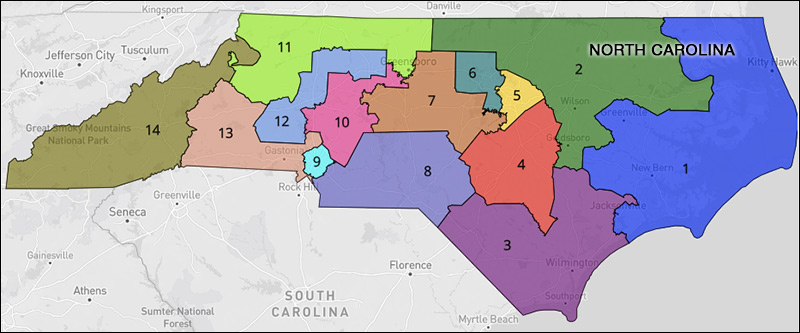
2022 North Carolina Congressional Redistricting Map (click on image or here to go to interactive map: Dave’s Redistricting App)
By Jim Ellis
Feb. 23 2022 — Both houses of the North Carolina state legislature have now passed a new congressional map to replace the original version that the state Supreme Court previously rejected.
The new plan now undergoes judicial review as early as tomorrow before final enactment. The legislators agreed upon a plan to meet the pre-determined judicial schedule. The districts must be set to meet an impending March 4 candidate filing deadline for the March 8 primary that was initially postponed to May 17. Any further redistricting delays will likely move the primary once more, this time to June 7.
The high court struck the plan because the justices determined the map was a political gerrymander and, on the original map, that Democrats were under-represented.
The previous map would likely have produced 10 Republican victories as opposed to four Democratic wins. The current division in 8R-5D. The state gained a new seat in national reapportionment, thus increasing the Tar Heel state delegation to 14 members.
The proposed map is certainly more competitive. Preliminary analysis suggests that the Republican nominee would be favored in six of the seats and the Democrats four, with an additional four being cast into a highly marginal category.
The legislature also restored the previous numbers to the districts, making statistical comparisons easier to understand. The members receiving what should be favorable districts are: Reps. Deborah Ross (D-Raleigh; District 2), Greg Murphy (R-Greenville; District 3), Virginia Foxx (R-Banner Elk; District 5), Richard Hudson (R-Concord; District 8), Dan Bishop (R-Union County; District 9), Patrick McHenry (R-Lake Norman; District 10), Madison Cawthorn (R-Hendersonville/Asheville; District 11), and Alma Adams (D-Charlotte; District 12).
Democrats would then be favored in open District 1 (Rep. G.K. Butterfield (D-Wilson) retiring) and open District 4 (Rep. David Price (D-Chapel Hill) retiring).
Incumbents relegated to highly competitive seats are Reps. Kathy Manning (D-Greensboro; District 6) and David Rouzer (R-Wilmington; District 7). The Dave’s Redistricting App statistical organization rates the Manning 6th District as a seat having a voting pattern that divides the two parties by less than one percentage point: 49.44 percent for Republicans and 49.18 percent for Democrats. The Rouzer District 7 breaks similarly: 49.39 percent for the Democrats and 49.04 percent for Republicans.
According to the FiveThirtyEight statistical organization that has not yet scored the new plan, the previous Manning 6th District rated as a D+21 and the Rouzer 7th CD, an identical partisan spread of R+21. Therefore, these two districts going to an even rating clearly changes the entire map’s outlook, and obviously so for this pair of incumbents.
Additionally, the original inter-party pairing between Reps. Foxx and Manning in a new District 11 that would favor the Republicans is no longer in effect.
The proposed map also creates two new marginal open seats. The 13th CD would stretch from the south Raleigh suburbs down through Johnston, Sampson, Duplin, and part of Wayne Counties. The Dave’s Redistricting App split is 50.08 percent for the Republicans and a 48.26 Democratic percentage.
The new 14th CD would include the western Charlotte suburbs in Mecklenburg County, and then move westerly to capture Gaston, Cleveland, and part of Rutherford Counties. The new seat would break 49.44 percent for the Republicans with the Democrats at virtual parity with a 49.05 percent average performance figure.
In a good year for each party, the map could swing by at least four seats. This means, in a strong Republican year, the GOP could achieve a 10R-4D split. Conversely, in a Democratic wave year, the party could soar to an 8D-6R division.
It remains to be seen whether the courts will approve this version. Republicans obviously hope this year unfolds for them to the degree that early predictions might suggest. Therefore, a marginal map such as this would likely cut their way.
